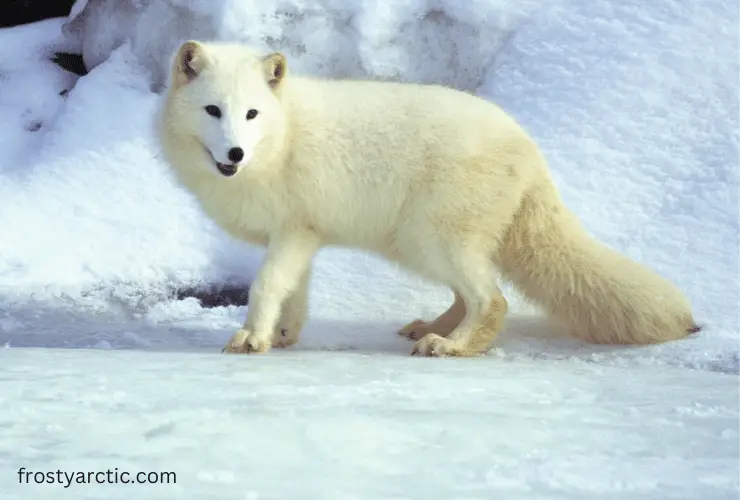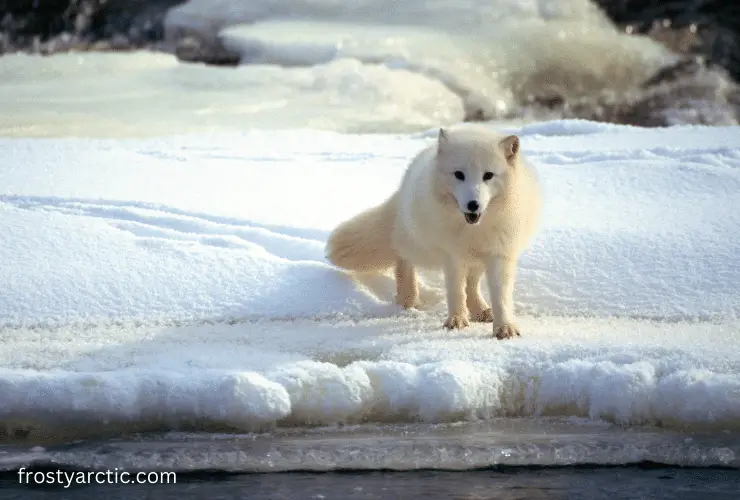The Arctic Fox faces many challenges, including threats from predators. Arctic foxes’ predators include red foxes, wolves, grizzly bears, polar bears, golden eagles, and even humans who hunt them for their fur. Most of these animals prey on Arctic foxes to eliminate competition for food sources.
Arctic foxes can only survive for 3 to 4 years in the wild. Let’s learn more about Arctic fox predators in this article.
Where is The Arctic Foxes’ Habitat?
Arctic foxes are found in the northern hemisphere, primarily the Arctic tundra. It is among the few animals native to Iceland found that made its way to the islands of the Arctic.
Arctic foxes are extremely tough animals, well adapted to surviving the frigid temperatures of the Arctic tundra. These animals can survive in temperatures as low as -58 degrees Fahrenheit.
In winter, Arctic foxes spend their time on the sea ice. They avoid going south because of the presence of red foxes that outnumber them in the area.
Did you know? It is common for fox families to live in dens in the open tundra or hidden under rocks on a cliff. The den features several entrances and a network of tunnels. ~ SDZwildlifeexplorers.org
Do Arctic Foxes Have Predators? Who Are the Arctic Foxes Predators?
Yes, Arctic foxes have several predators. Animals that dominate the Artic tundra include Arctic foxes, red foxes, caribou, golden eagles, bald eagles, snowy owls, and wolves.
In mainland Europe, the Arctic fox population is in decline. In the North, the dominance of red foxes increases. These predatory animals mainly target the offspring of Arctic foxes. This explains why Arctic foxes prefer to give birth in the shelter of their dens.
Research has also shown that these animals are mainly interested in healthier arctic foxes compared to weaker ones. Details on their predatory behaviors have been given below:
| List Of Predators | Types of Predators | Special Specticulation Regarding Arctic Foxes and Predators | |
| Golden eagles | Arctic foxes and golden eagles have similar diets, but this does not make them friends. | Golden eagles are one of the most common predators of Arctic foxes. They work in teams to chase and grab Arctic fox offspring. Golden eagles cannot carry a 15- or 20-pound calf. It devours its prey where it lays without skinning it. | |
| Snowy owls | Snowy owls and Arctic foxes compete for lemmings and other small rodents. When food is in short supply, the competition between them gets fiercer. | Snowy owls face no problem killing Arctic fox kits.They use their talons to attack Arctic fox offspring. Snowy owls might even kill adult foxes in some cases. On the other hand, Arctic foxes also feed on snowy owl eggs. So, the predator-prey relationship goes both ways. | |
| Wolves and Wolverines | Both wolves and Arctic foxes belong to the candid family. They are carnivores and their diet consists of larger mammals such as caribou and muskoxen. Wolverines belong to the weasel family and are very different from Arctic foxes. Similar to Arctic foxes, they are opportunistic carnivores. | Research has shown that wolves eat arctic fox offspring; Arctic hare, and lemming.Wolverines have also been observed feeding on carcasses from fox dens. | |
| Polar bears | Although Arctic foxes are not the primary prey of polar bears, they are considered the natural predators of these animals. | Polar bears don’t feed on Arctic foxes if food is good in supply.During the summer months, the food supply is often inadequate. In such cases, polar bears might hunt Arctic foxes, following them around for carcasses. | |
| Brown bears | Like polar bears; brown bears are also natural predators of Arctic foxes. | These bears can dig out of their dens which is why they pose a threat to Arctic foxes | |
| Red foxes | Both Arctic foxes and red foxes belong to the same family. Despite that, their relationship is not a friendly one! Research suggests that Arctic foxes are superior in terms of strength to arctic foxes. These predators don’t just kill Arctic foxes for food, but they also do so to eliminate competition. These predatory animals also kill the offspring of Arctic foxes. | Red foxes are one of the primary reasons why Arctic foxes are endangered.The camouflage of Arctic foxes is no longer effective in shielding them against red foxes because of climate change. Consequently, they are gaining dominance in the Arctic region. |
Luckily, they boast several biological adaptations that help them avoid unwanted attention from predators, as explained later in this article.
Are Arctic Foxes Predators or Prey or Both?
Arctic foxes are both predators and prey. Their predatory nature helps them hunt for sustenance for survival.
We already know who the Arctic fox predators but what animals do Arctic foxes prey on?
These furry Arctic creatures are opportunistic feeders, meaning they feed on any animal they might find, whether alive or dead. Their diet mainly consists of rodents such as lemmings, voles, and other tiny mammals.

They might also eat insects, berries, birds, and reptiles. They might chase polar bears or wolves and feed on their leftovers if food is scarce.
But they must remain very careful in such situations because there is a chance that they might become the next meal for these predators.
Fun Fact: The Arctic fox might starve if the lemming population fluctuates. This is one reason Arctic fox populations rely highly on the lemming population. (Source)
How Do Arctic Foxes Survive from Predators: How Do They Avoid Predators?
Arctic foxes are clever animals with several tactics to hide from predators. Their color-changing fur coat plays a major role in avoiding predators.
During the winter, their coat is a pure white color, perfect for blending in with the snow-covered environment. In summer, however, their fur takes a brown or gray appearance, camouflaging them with the environment.
This biological adaptation serves as a shield against predators and prevents eagles, polar bears, and wolves from spotting them on the ground.
They live in generation-old dens not just for shelter but also to hide from predators. The females even give birth in the shelter of these dens.
Arctic foxes belong to the candid family, meaning they have extremely sharp hearing. This also helps them sense predatory movements and seek shelter if they detect a threat.
Are Arctic Foxes Aggressive?
Just like many other animals, Arctic foxes are not aggressive toward humans until they perceive them as a threat, especially to their offspring.
However, if they have rabies, they might exhibit aggressive behavior. It is best to avoid touching the animal if this is the case. Bites from foxes can be dangerous, especially if they have rabies.
FAQs:
1. What are the arctic foxes’ biggest predator?
Polar bears and wolves are among the biggest predators of Arctic foxes. Birds, including golden eagles and may, snatch fox babies.
2. Do polar bears eat arctic foxes?
Yes, polar bears are one of the predators of Arctic foxes but prefer feeding on seals and aquatic animals instead of these animals.
3. What kills an Arctic fox?
Wolves often kill Arctic foxes, while bears and golden eagles prey on the offspring. The Arctic wolf is a major threat to these foxes.
Conclusion
Arctic foxes are strong animals built to survive the cold temperatures of the Arctic. However, their numbers are declining sharply because of global warming, lack of food sources, and rising temperatures. They are both predator and prey.
I hope this article provided adequate information on arctic foxes’ predators, their survival modes, and more.



5 thoughts on “Who Are the Arctic Foxes’ Predators?”